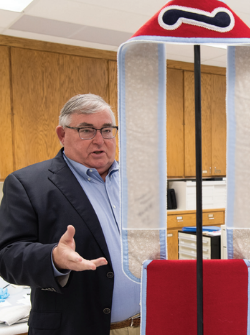 Most collectors don’t set out to collect art; rather they discover an interest emerging from a series of life experiences. Museum visits are one such experience. In fact, Mr. Gilcrease himself developed his interest in collecting after visiting European museums on business in the mid-1920s.
Most collectors don’t set out to collect art; rather they discover an interest emerging from a series of life experiences. Museum visits are one such experience. In fact, Mr. Gilcrease himself developed his interest in collecting after visiting European museums on business in the mid-1920s.
Such is the case with Sharon Bell, who with her husband, Greg Gray, recently gifted Gilcrease with several pieces of art from their collection. Bell recalls her first visit to Gilcrease was as a student in elementary school. She began buying art while in college.
“I went to art festivals in Oklahoma City and met gallery owners through my parents,” she recalled. Rennard Strickland, University of Oklahoma law professor and collector, influenced her parents’ collecting and therefore hers as well.
Gray grew up in Muskogee and, consequently, was familiar with the Native artists who worked in the area, such as Jerome Tiger, Willard Stone and Acee Blue Eagle. Gray remembers seeing a mural by Blue Eagle in Muskogee’s Carnegie Library while he was growing up.
“I didn’t start collecting as early as Sharon, but developed an interest in Gilcrease after moving to Tulsa because of my exposure to these artists back in Muskogee,” Gray said. “It was natural.”
Together, their collection grew, being influenced by other collectors, their travels and their connection to Gilcrease Museum and Tulsa, where the couple collected work by Rendezvous artists, among others. In fact, it was a trip to Victoria, British Columbia that gave birth to an interest in Northwest Coast art – particularly that of Tony Hunt and family – which made up about half of their recent gift to Gilcrease.
“We started collecting art as mementos of our trips. We visited a gallery in Victoria and the art spoke to me. I really liked the colors. I had a number of hours of anthropology study and these works told stories I thought were significant, stories that were important to the culture,” Bell said.
Gray developed an interest in Regionalism and printmaking after seeing an exhibition of work by the Dallas Nine, a group of painters, printmakers, and sculptors active in Dallas in the 1930s and early 1940s. Among the group was Alexandre Hogue, who later became chair of the art department at The University of Tulsa (Hogue remained in Tulsa for nearly 50 years after taking the post).
“I worked with gallery owners in Dallas and Tulsa to acquire pieces,” said Gray, who currently serves as a member of the Gilcrease Museum National Advisory Board, and spent many years on the Thomas Gilcrease Museum Association Board before the City of Tulsa’s partnership with TU commenced. (In total, the couple has spent more than 20 years as board members of Gilcrease and TU.)
Bell and Gray have made their affinity for Gilcrease a family affair. Both recall with smiles bringing their son, John, in a stroller to the museum and standing in front of Albert Bierstadt’s Sierra Nevada Morning, where John would point out, “Deer! Deer!” in the painting.
“I don’t know,” Gray wondered. “I think that could be part of the reason why John is fond of the outdoors as an adult.”
John, like his parents, has developed a bit of an interest in collecting. While Northwest Coast material isn’t his preference, he does have an interest in the Oklahoma artists in the collection and while at TU did a research paper on Willard Stone.
Bell concluded, “Gifting art is like letting go of children. It’s hard.”
However, Gray doesn’t find letting go quite as difficult. According to him, a number of pieces they collected were acquired with Gilcrease in mind.
Either way, Bell and Gray are still collecting today, keeping Gilcrease in mind and cementing the family’s life-long ties to the museum.
A Closer Look
By Laura Fry, Senior Curator and Curator of Art
As Gilcrease Museum continues to expand its collection with examples of 20th-century and contemporary artworks, the group of artworks donated by Sharon Bell and Greg Grey present new perspectives from the 1930s through today. In 2018, Sharon and Greg generously donated works by artists from near and far. New works on paper by Lois Smoky and Charles Banks Wilson are joined by bold serigraph prints by Indigenous artists of the Pacific Northwest. The donation also contains three-dimensional works, including Cherokee beadwork and formline woodcarving from the Northwest Coast.
The gift includes a Bandolier Bag by Martha Berry, a noted Oklahoma artist who was designated a Cherokee National Living Treasure in 2013. She researches historical beadwork styles of southeastern woodland Native nations, and her beadwork often illustrates stories of her Cherokee ancestors. Martha has been involved at Gilcrease Museum as a teacher and workshop leader, and this will be the first example of her work to join the museum’s permanent collection.
In addition to Oklahoma artists, Sharon and Greg are drawn to the distinctive art forms of the Northwest Coast. Their gift includes a wood headdress in the form of a surreal green bird, carved by celebrated Kwakwaka’wakw artist Beau Dick. From Alert Bay in British Columbia, Dick began carving at age 15 and introduced Kwakwaka’wakw culture and traditions to a broader audience through his work. As a contemporary work, his headdress makes a significant addition to the historical Northwest Coast material in the Gilcrease Collection.
We look forward to sharing the treasures from Sharon and Greg’s donation to Gilcrease through the online collections and in future exhibitions.